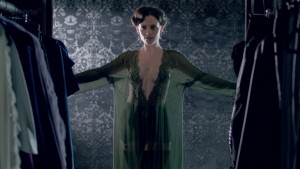Dracula and the Harry Potter series share eerie similarities: Dracula features an antagonist who was within society and became evil, just as Voldemort was on track to become a wizard, and decided to instead declare war on his society. Dracula and Mina are psychically connected and Dracula can control Mina, just as Harry and Voldemort can read each other’s thoughts and Voldemort can control Harry (Stoker 344). Mina has a wafer burn on her forehead, a mark of Dracula’s influence on her; Harry has a scar on his forehead, where Voldemort attempted to kill him. Voldemort and Harry have wands whose core came from the same exact phoenix, showing they are inherently connected; Dracula’s blood runs through Mina’s veins.
Both novels also expose a fear of pollution or contamination within society. Harry worries that he will turn bad like Voldemort since his life resembles Voldemort’s and he contains some of Voldemort’s soul. Likewise, Van Helsing notes changes in Mina after Dracula bites her, including “her eyes are more hard” (Stoke 344). Both books contain an anxiety that the evil will overtake the good, and that we can see warning signs of this, whether the person is becoming a vampire or an evil wizard. All these concerns show that perhaps there is a pattern to societal anxieties that has not changed much since the 1890’s. Dracula and Harry Potter are so popular because they are relevant to culture; their messages really do represent some of our cultural anxieties. Perhaps they have so much in common because there is a pattern to cultural anxieties, one that changes little regardless of era or world (real or wizarding).
Considering the similarities the novels share, especially in how the villain affects the “hero,” we can glean insight into cultural anxieties. The villain and the hero are irrevocably connected by something we cannot even see, and therefore have no control over. Harry and Voldemort’s wands share a core connection, and Dracula’s blood circulates through Mina’s body, indistinguishable from her “pure” blood (another Harry Potter reference). Perhaps society’s inability to separate the good from the bad represents an anxiety over reverse invasion and its undetectable qualities. We cannot pry apart Mina’s blood from Dracula’s, so we never know if Mina is purely herself, or if she operates under Dracula’s influence. Similarly, Harry has some of Voldemort’s qualities (the ability to speak parseltongue, legilimency, etc.), and we learn that Voldemort actually implanted some of his powers into Harry when he tried to kill Harry. Thus, the two are intrinsically connected, and “one cannot live while the other survives.” This obsession with penetration and planting a seed in someone is prevalent in both novels because it is so irreversible and intimate, making it a major cultural anxiety.
This uncontrollable, permanent connection terrifies 1890’s England and the 1990’s wizarding world. It represents reverse invasion because it presents a case in which it is impossible to determine who is “supposed” to be in the society and who is a “foreigner.” Because we cannot determine who is stained with the enemy’s influence, we risk invasion by allowing “good” people to operate within society even though they have been contaminated. Authorities do not banish Mina or Harry from society, but in doing that they risk giving the enemy access to society through presumed “good” people.
Dracula and Harry Potter share many similarities, all of which show that villains present a threat to society’s health. Van Helsing even describes Dracula as, “only [a] body groping his so small measure in darkness and not knowing,” (Stoker 340), which is exactly how Voldemort’s body was after he tried to kill baby Harry. These similarities show that 1890’s England and the wizarding world (and perhaps any society) were scared of the outsider coming in and upsetting the balance. Both stories end, too, with a restoration of order. Dracula dies and Harker notes that, seven years later, England has reproduced (Mina and Harker have a child), and society regains its health. Harry Potter has to fight Voldemort to eliminate the threat Voldemort poses, and the last chapter of the Harry Potter series emphasizes that “all [is] well.” Harry, Ron, and Hermione have reproduced and Hogwarts has returned to its usual self. It seems the threat to cultural balance persists through eras and across worlds, and given Dracula and Harry Potter’s lasting popularity, the anxieties they represent persist, too.
